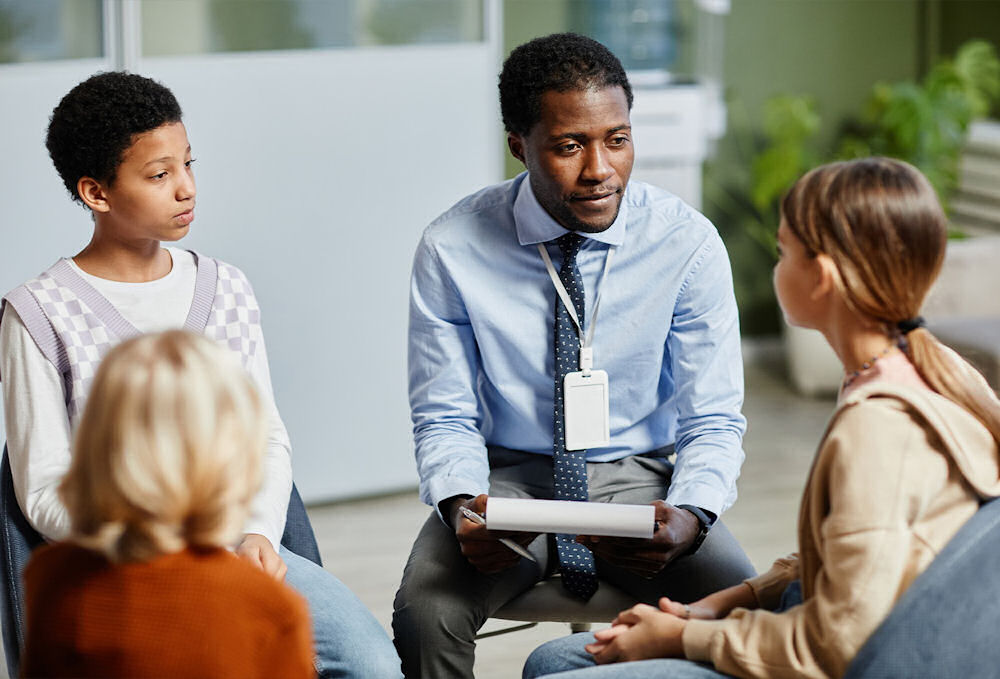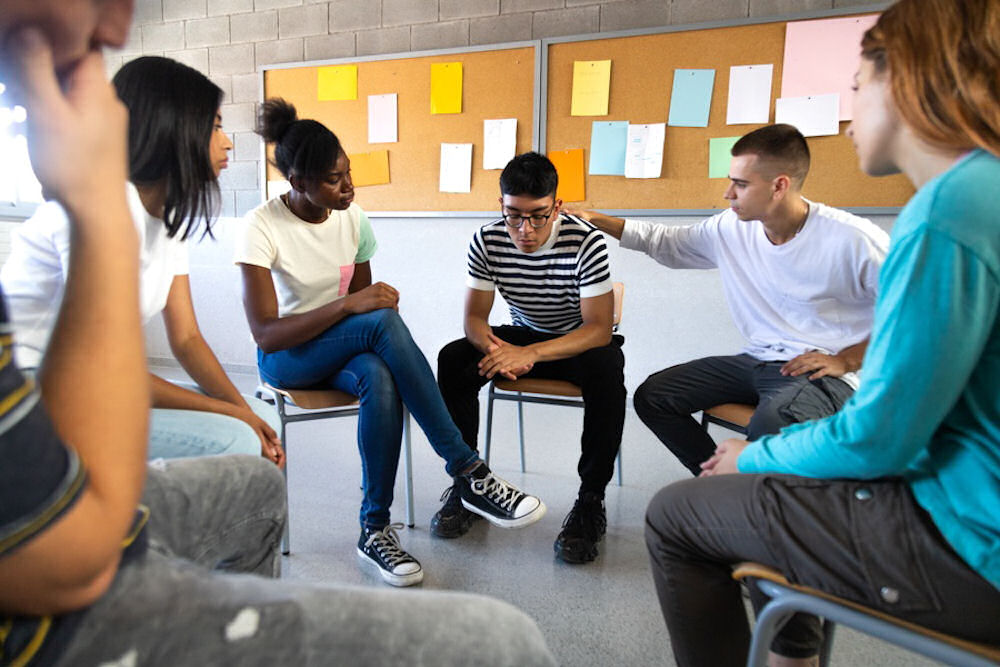
If you have an adolescent or young adult who is struggling with a mental health issue, there is help at Blume Behavior Health in Redondo Beach, California. The professionals at Blume Behavioral Health are dedicated to the well-being of teens and have created a community where they can learn to change their lives and thrive through group therapy.
Group therapy is considered the best and most reliable standard for outpatient care, but research has shown that it’s as effective as individual counseling. Bullies, relationship issues, and peer pressure are among the many reasons why a teen may withdraw from family members and close friends. Group therapy can help them understand that they’re not alone while building a judgment-free environment to help examine their mental health issues with others.

Working toward mental health goals requires a collaborative effort. Every session of group therapy calls for active participation. This can make all the difference for teens. Group members feel more comfortable after seeing others open up and participate. In addition, teens are inspired to participate because they can trust that what happens in the group will stay in the group.
Loneliness peaks during adolescence, arising from feeling misunderstood or disconnected from others. However, group therapy can help them build meaningful connections with their peers. In a group setting, teens can share their feelings and thoughts with others who can recognize and relate to their struggles, building a sense of support. Validation and normalization like this create a much-needed feeling of belonging for many adolescents.
At the same time that teens feel a sense of connection in group therapy, the group feature also brings together people who have unique experiences, backgrounds, and points of view. While they share their thoughts and feelings, they also hear diverse stories from their peers. This diversity helps them understand the world better and offers different ways to cope with challenges. The mix of experiences creates a welcoming space where teens can connect with different elements of their peers’ stories and learn new things.
As teens see the different coping strategies and perspectives of the other group members, they acquire valuable insights that can help them change their attitudes and behaviors. The fellowship in the group promotes a sense of accountability. This motivates teens to set personal goals and work towards them. Through active participation, constructive feedback, and a collective commitment to growth, teens are empowered to:
Healthy relationships are an important source of support for teens, whether it’s family relationships or romantic partners. A stable relationship is built on trust, honesty, and support, but teens may not have the ability to recognize unhealthy relationships. Through the development of healthy relationships in group therapy, teens can recognize what a healthy relationship looks like. They learn the warning signs for unhealthy interactions and can take steps to make sure that their relationships have strong foundations.
Groups also give teens a chance to practice healthy social and communication skills such as active listening and strategies for handling conflict. An important part of group therapy for teens is that it helps them foster healthy relationships with themselves. Through group activities, they can cultivate sustainable self-care strategies to manage stress and learn coping skills.

Group therapy is a useful clinical practice for teens with mental health issues because peer groups are a natural setting for young adults. Typically, groups are made up of young people who:
Group sessions of this type result in a complex communication system.
The goal of group therapy is to promote maturity and independence through interactions between peers and the therapist in a safe environment. At the beginning of the group, communication usually radiates outward toward the group members from the formal group leader, the therapist. As time goes by it becomes “circular,” with the participants mediating and showing interest in each other. This change in communication indicates the group process.
The therapist must use 4 core strategies to create a communicative environment that allows the teens to grow. These strategies are:
The exact way a session is conducted, and any of the activities, depends mainly on the goals of the group and the therapist’s style. Some might encourage a more free-flowing style of dialogue where each person participates as they see fit. Still, other therapists have a specific plan for each session that may include having members practice new skills with each other.
Common group activities include:
There are different groups available to address different issues. In general, a small group of kids working through similar stressors are placed together. Groups are typically small in size, with about 8 to 10 participants depending on the nature of the group. In some cases, groups are organized by gender, but many groups focus on working through a specific issue (ex: social skills, anxiety, etc.). Examples of group therapy include:
CBT groups help teens recognize inaccurate thinking that has reinforced their negative behaviors. They are usually focused on a specific issue. They are especially effective with anxiety and substance use disorders.
DBT emphasizes a combination of individual therapy and group skills training classes to help teens learn and use new approaches to improve their emotional functioning. Skills learned in DBT include:
Process groups help teens work through stressors in a supportive and safe environment. Examples of process groups include grief groups, groups to work through bullying, eating disorder groups, play therapy groups, and empowerment groups. Process group therapy is an effective tool in helping teens learn how to trust others, share experiences, and give and take supportive feedback to and from peers.
There are a lot of benefits for teens who take part in group therapy, but there are three main benefits of group therapy programs. They include:
When a teen goes through a traumatic experience, they frequently become withdrawn and unable to manage their feelings. They then resort to isolating themselves from others. A 2021 study found that teen depression has increased by 59% since 2007. Group therapy helps teens see that others are experiencing similar situations. Therapy offers teens the opportunity to share their internal struggles with others and develop strategies to handle their feelings. Working with others helps them discover that their struggles are normal.
When teens realize that they can work through their issues with support from other people, they become willing to accept feedback from their peers. Teenagers love to give and receive advice from their peers. In sessions, they can share their knowledge and experiences. They can then internalize the power of their messages, making them feel wise to their peers.
When adolescents realize that they aren’t alone in their feelings and that they can help others with their ideas, they are naturally empowered. In therapy, teens often uncover feelings of hope and relief by talking to other teens about their experiences. Just knowing that they aren’t grappling with depression, anxiety, ADHD, or trauma alone helps them overcome their struggles in a supportive environment. Additionally, when they realize their goals have been achieved by peers, they work even harder to find personal success.
You may use a combination of community-based and online resources:
Trust yourself. You know your child and if you suspect there’s a problem, getting guidance and support from a professional is always best. In addition, more happens in a teen’s life than a parent knows. Talk to siblings, teachers/coaches to see what they think.
Pick a low-key time of day and say “I love you and I have noticed that you seem (feeling or behavior) lately. I found a therapist for us to see to talk about how we can help you feel better.” Talking while driving is also a low-pressure time to talk and they can’t walk away. Reinforce the fact that they can tell the therapist things they can’t tell their parents and it stays confidential.
Tell them that you value their opinion but the ultimate decision is up to you. If they had a physical issue, there wouldn’t be any discussion about whether or not they got treatment. Mental and emotional health is just as important as physical health. You may have to resort to bargaining a reward for attending therapy and cooperating such as new clothes or extended curfew. Once they go, most are happy they did.
In the Redondo Beach, CA area, there is teen group therapy available at Blume Behavioral Health. Our goal is to leave nothing to chance when it comes to your child. We can offer your teen:
You are the expert in your child’s behavior, and if you suspect there’s an issue, you need to take action now. Blume Behavioral Health will conduct a comprehensive assessment of your child to create a personalized treatment plan and keep you involved in the recovery process. You want the best for your teen and we can help. Contact us today.
Dr. Aneta Lotakov Prince is a board-certified psychiatrist with over 20 years of clinical experience treating adolescents and adults facing severe mental illness, co-occurring substance use disorders, and complex emotional and behavioral health challenges. Certified by the American Board of Psychiatry and Neurology, she holds an active DEA registration and California medical license. Dr. Prince’s patient-centered approach is rooted in compassion and driven by a dedication to improving quality of life and supporting long-term recovery. She remains deeply committed to empowering each individual she works with to build a life of purpose, connection, and resilience.